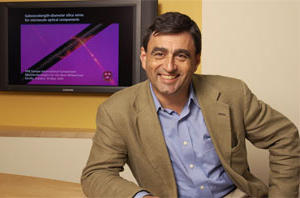Professor Eric Mazur
The Guardian article “Black silicon” boosts solar cell efficiency said
“An ultra-sensitive form of the silicon used in most solar panels may soon help to harness the near limitless power of the sun. Thanks to an extremely rough surface, ‘black silicon’ can absorb more light and can also trap a wider range of frequencies, including infra-red rays, that normally pass straight through standard silicon.Eric Mazur, a physicist at Harvard University, discovered black silicon by accident in his laboratory in 1998 when one of his research team blasted normal silicon with a very short laser pulse. Almost a decade later, the company created to commercialize his work, SiOnyx, has announced the production of the first commercial-grade wafers.
While producing electricity from the sun’s rays has enormous potential, the industry has been hampered by the high cost of silicon wafers. Research teams around the world have been hunting for ways to bring down costs by improving the efficiency of solar cells.
Mazur said that photovoltaic (PV) cells using black silicon would significantly increase the efficiency of modern panels, the majority of which only convert around 8% of the energy falling on them into electricity. The very best convert around 20%. He said that a black silicon wafer could approach the theoretical limit of converting around 30%–40% of the energy falling on it into electricity.”
Eric Mazur, Ph.D., FOSA, FAPS is the Balkanski Professor of Physics and Applied Physics at Harvard University. An internationally recognized scientist and researcher, he leads a vigorous research program in optical physics and supervises one of the the largest research groups in the Physics Department at Harvard University.
After obtaining a Ph.D. degree in experimental physics at the University of Leiden in the Netherlands in 1981, Eric came to Harvard University in 1982. In 1984 he joined the faculty and obtained tenure six years later. He has made important contributions to spectroscopy, light scattering, the interaction of ultrashort laser pulses with materials, and nanophotonics.
In 1988 he was awarded a Presidential Young Investigator Award. He is Fellow of the Optical Society of America and Fellow of the American Physical Society, and has been named APS Centennial Lecturer during the Society’s centennial year. In 2007 he was appointed Phi Beta Kappa Visiting Scholar. In 2008 he received the Esther Hoffman Beller award from the Optical Society of America and the Millikan Medal from the American Association of Physics Teachers.
Eric has held appointments as Visiting Professor or Distinguished Lecturer at Princeton University, Vanderbilt University, the University of Leuven in Belgium, National Taiwan University in Taiwan, Carnegie Mellon University, and Hong Kong University.
In addition to his work in optical physics, he is interested in education, science policy, outreach, and the public perception of science. He believes that better science education for all — not just science majors — is vital for continued scientific progress. To this end, Eric devotes part of his research group’s effort to education research and finding verifiable ways to improve science education. In 1990 he began developing Peer Instruction — a method for teaching large lecture classes interactively. His teaching method has developed a large following, both nationally and internationally, and has been adopted across many science disciplines.
Eric has served on numerous committees and councils, including advisory and visiting committees for the National Science Foundation, has chaired and organized national and international scientific conferences, and presented for the Presidential Committee of Advisors on Science and Technology. He serves as consultant to industry in the electronics and telecommunications industry.
In 2006 he founded SiOnyx, a company that is commercializing black silicon, a new form of silicon developed in his laboratory. He is currently Chairman of the Scientific Advisory Board for SiOnyx. He also serves on the Scientific Advisory Panel for Allied Minds, a pre-seed investment company creating partnerships with key universities to fund corporate spin-outs in early stage technology companies.
Eric is author or coauthor of 214 scientific publications and 12 patents. He has also written on education and is the author of Peer Instruction: A User’s Manual (Prentice Hall, 1997), a book that explains how to teach large lecture classes interactively. In 2006 he helped produce the award-winning DVD Interactive Teaching.
Eric coauthored Micromachining bulk glass by use of femtosecond laser pulses with nanojoule energy, Subwavelength-diameter silica wires for low-loss optical wave guiding, Laser-induced breakdown and damage in bulk transparent materials induced by tightly focused femtosecond laser pulses, Single-mode guiding properties of subwavelength-diameter silica and silicon wire waveguides, Femtosecond laser-induced formation of spikes on silicon, Ultrafast electron and lattice dynamics in semiconductors at high excited carrier densities, and Ablation of cytoskeletal filaments and mitochondria in live cells using a femtosecond laser nanoscissor.
His patents include Femtosecond laser-induced formation of submicrometer spikes on a semiconductor substrate, Subwavelength-diameter silica wires for low-loss optical waveguiding, Systems and methods for light absorption and field emission using microstructured silicon, Manufacture of silicon-based devices having disordered sulfur-doped surface layers, and Silicon-based visible and near-infrared optoelectric devices.
Watch From Questions to Concepts: Interactive Teaching in Physics, Guiding Light w/Nanowires – Total Internal Reflection, and Bok Center Video Preview.
